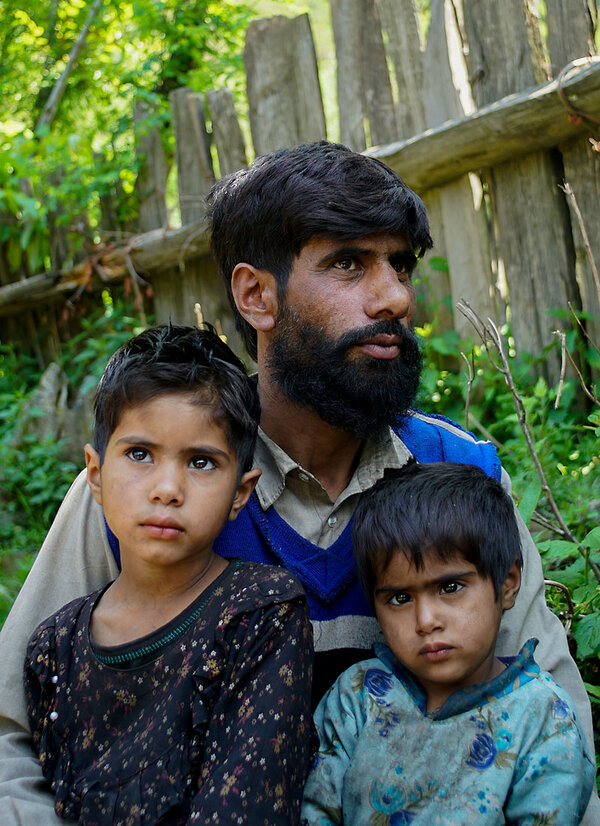It takes Mubarak Hussain Bajard two hours of trekking through dense forests to reach his classroom, careful to avoid the wild animals that live in the mountains of Dardpora, India.
When he arrives, a group of 16 children is waiting in the tree shade – all are members of Kashmir’s remote, pastoral communities, where literacy rates have historically lingered around 30%. As his whiteboard goes up, 16 books open, and the courtyard reverberates with recitations.
This is one of a growing number of mobile schools for shepherds.
Backed by regional education authorities, the schools have a curriculum that focuses on traditional academic subjects as well as life skills, environmental awareness, and cultural preservation. The teachers who run these open-air classrooms also serve as mentors and role models for the children. Many come from nomadic communities themselves and understand the unique challenges faced by the region’s shepherds.
“They are our children, and we want to make a difference in their lives,” says Mashkoor Ahmed Koka, another teacher. “Just remember: If one of them gets educated, it will have an impact on the whole community.”
Teachers bring passion to the pastures
Across India, tribal communities have long struggled to boost literacy rates and overall interest in education. Common challenges include seasonal migration, teacher absenteeism, and lack of motivation on the part of parents.
The Gujjars and Bakarwals – pastoral nomads who live throughout Jammu and Kashmir – are no exception.
This is why, high in the mountains surrounding the Kashmiri village of Dardpora, the local education department has set up around 25 mobile schools, providing a ray of hope for children who would otherwise have limited or no access to education. Head Clerk Nasir ul Islam says education officers select teachers – who make a salary of $120 per month and receive tents and other supplies from the government – and carry out surprise visits to the schools throughout the school season, which starts as early as April and runs to September or October, depending on weather. And officials say demand for mobile schools is growing.
This year, more than 1,000 schools served tens of thousands of children throughout Kashmir.
Nizamuddin Gojjar Khatana has three children participating in the program – the only members of the family enrolled for formal education. “I have ruined my life by ignoring the importance of education, but I won’t let it happen to my children,” he says.
Mr. Khatana praises their passionate teacher, Shaista Akhtar. Born and raised in a nomadic family, she witnessed firsthand the struggles faced by her students, and received her primary education at a similar school for little shepherds. Determined to make a difference, Ms. Akhtar continued her studies at a local high school, and started teaching five years ago, at age 19.
“There are only two to three female teachers” in the Dardpora area, she says. “And it is not easy to break the shackles of ignorance. I have to convince and motivate the children.”
Her hard work has not gone unnoticed. “Apart from teaching, she inspires our children to take education seriously,” says Mr. Khatana, adding that his children can already read and write, unlike him.
Juggling chores, cattle, and homework
Yet nomadic students must also balance their desire for education with the responsibilities related to grazing livestock.
Children from pastoral communities are expected to participate in crucial grazing activities from a young age. Boys are primarily responsible for herding cattle, while girls are expected to take care of household chores and help with the animals when needed.
To get their education, teenage cousins Khalida Akhtar (no relation to Ms. Akhtar) and Jeelani Ahmed go the extra mile. They leave early in the morning to take cattle to the grazing fields, and even still, they often run late for class.
“It takes us a couple of hours to look for greener pastures,” says Jeelani. “We want to get education like other kids get, but we have the responsibility of grazing cattle on which our livelihoods depend. That’s why we juggle.”
Their tardiness doesn’t anger their teacher. “The grazing of cattle is passed down from one generation to another. We have to be supportive,” says Mr. Koka. “If they are careless in taking care of cattle, they get scolded by their parents.”
After school, the duo immediately scurry back toward the grazing field.
Khalida, an extroverted teen with dreams of becoming a doctor, does her homework late at night, after class is done, the cattle is home, and the household chores are complete. Her schedule is tiring, and unpredictable, but she’s grateful for the chance to learn.
“If there were not these schools around our bahaks [temporary settlements], we would not be able to get an education,” she says.
It’s a hopeful sentiment echoed by their teachers.
“Their fathers and forefathers remained uneducated. If there were no nomadic schools around, the fate of children would remain the same,” says Mr. Bajard. “It is because of these schools, that there are nomadic people into the different professions. Education, of course, can open any door.”









